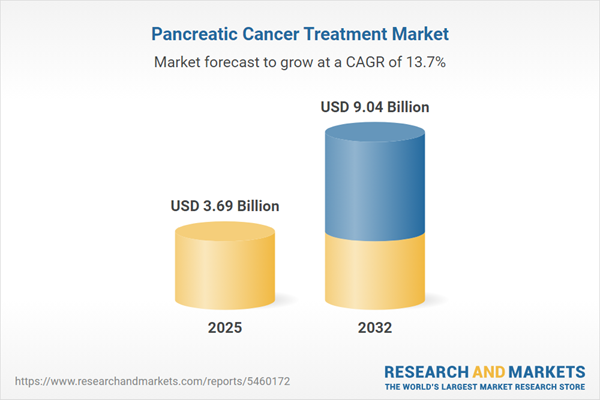Speak directly to the analyst to clarify any post sales queries you may have.
The pancreatic cancer treatment market is evolving rapidly, shaped by digital health integration, new therapy innovations, and shifts in regulatory and care standards. Senior decision-makers face an increasingly complex environment where anticipating change and aligning strategic initiatives is essential for continued growth and organizational value.
Market Snapshot: Growth and Trends in the Pancreatic Cancer Treatment Market
The pancreatic cancer treatment market is demonstrating consistent global growth, propelled by technological advancements and a stronger emphasis on patient-centered models. Immuno-oncology is accelerating progress, while regulatory agencies actively support faster therapeutic approvals. This environment is widening patient access and emphasizing the importance of adaptable competitive strategies. Adoption of digital health tools has improved clinical connectivity and research activity, prompting collaborations between healthcare systems and manufacturers. These trends reinforce dynamic pipelines and enable agile responses to ongoing market change while solidifying the role of innovative care teams.
Scope & Segmentation of the Pancreatic Cancer Treatment Market
Senior leaders can optimize strategies and investments by targeting the most influential market sectors. The following dimensions define the competitive landscape and shape operational, R&D, and regional priorities:
- Treatment Types: Established regimens like Capecitabine, Folfirinox, and Gemcitabine form the foundation, now complemented by CAR T-cell and checkpoint inhibitor immunotherapies. Vaccine-based solutions, as well as expanded palliative supports such as psychological, dietary, and pain management services, continue to expand. Developments in radiation therapies, new surgical options—like distal pancreatectomy, total pancreatectomy, and Whipple procedures—and targeted approaches using EGFR or PARP inhibitors are influencing care delivery across the continuum.
- Therapy Lines: The market supports treatments across all disease stages, spanning first- through fourth-line therapies. This provides flexibility for organizations to adjust protocols based on patient progression and optimize long-term outcomes.
- End Users: Delivery environments include ambulatory settings, oncology clinics, and hospitals. This diversification supports multidisciplinary collaboration and encourages equitable access to advanced treatment pathways throughout the patient journey.
- Distribution Channels: Reliable supply chains now operate through hospital, retail, and online pharmacies, ensuring robust therapy distribution and access for diverse populations across global regions.
- Regional Coverage: Market activity is present across the Americas, Europe, Middle East & Africa, and Asia-Pacific. Each region brings unique regulatory frameworks and adoption rates, requiring tailored engagement and localization to maximize participation and compliance.
- Key Players: Major organizations—including F. Hoffmann-La Roche, Eli Lilly and Company, Bristol-Myers Squibb, Merck & Co., Novartis AG, Pfizer, AstraZeneca, Sanofi, Johnson & Johnson, and Amgen—drive value through partnerships, investment in research, and continuous product innovation.
- Innovative Technologies: The integration of artificial intelligence is improving early detection, advancing precision care, and optimizing clinical workflows. These tools facilitate more personalized patient management and support operational efficiency in oncology practices.
Key Takeaways for Senior Decision-Makers
- Implementing interdisciplinary, patient-centric care models helps streamline resources and improve care coordination, supporting measurable outcome enhancements.
- Strategic collaboration among biotechnology, pharmaceutical, and clinical stakeholders expands innovation potential and accommodates shifting regulatory demands, boosting competitive positioning.
- Customizing strategic approaches regionally—especially regarding reimbursement policies and therapy distribution—enhances adaptability and maintains resilience amid evolving regulatory requirements.
- Leveraging real-world evidence with digital platforms increases operational efficiency and informs data-driven decisions for care optimization and resource allocation.
- Strengthening supply chain management secures continuous, compliant therapy access worldwide and reduces exposure to disruptions in sourcing and distribution channels.
- Applying analytics enhances segmentation and targeting efforts, supporting focused development of treatment options for varied clinical and operational landscapes.
Tariff Impact: 2025 United States Policy Implications
Upcoming tariff changes in the United States will require oncology manufacturers to enhance sourcing flexibility and logistics strategies. Maintaining proactive communication with regulators and supply partners will be critical to staying compliant and ensuring operational continuity. Utilizing real-world data supports more informed pricing strategies and allows for swift operational adjustments tailored to a shifting policy environment.
Methodology & Data Sources Overview
This report synthesizes robust secondary research, encompassing clinical trial data, regulatory sources, and expert perspectives from clinicians, payers, and logistics professionals. Technology evaluations and in-depth SWOT analyses underpin practical recommendations specifically designed for senior executives in the oncology and biopharmaceutical sectors.
Why This Report Matters to Your Strategic Initiatives
- Empowers senior executives to prioritize research investment, expand product pipelines, and identify actionable market opportunities for near-term growth.
- Clarifies procurement, supply chain, and operational challenges to help leaders drive efficiency and ensure business continuity throughout the oncology treatment cycle.
- Offers evidence-based perspectives on digital health and clinical advancements, equipping organizations to implement confident strategies for value creation and alignment across the enterprise.
Conclusion: Steering the Future of Pancreatic Cancer Treatment
This analysis equips executives with strategic clarity to guide organizational growth in pancreatic cancer treatment. By emphasizing innovation, collaboration, and patient-focused approaches, leaders can ensure long-term value and market resilience.
Additional Product Information:
- Purchase of this report includes 1 year online access with quarterly updates.
- This report can be updated on request. Please contact our Customer Experience team using the Ask a Question widget on our website.
Table of Contents
3. Executive Summary
4. Market Overview
7. Cumulative Impact of Artificial Intelligence 2025
List of Figures
Companies Mentioned
The companies profiled in this Pancreatic Cancer Treatment market report include:- F. Hoffmann-La Roche Ltd.
- Eli Lilly and Company
- Bristol-Myers Squibb Company
- Merck & Co., Inc.
- Novartis AG
- Pfizer Inc.
- AstraZeneca PLC
- Sanofi S.A.
- Johnson & Johnson
- Amgen Inc.
Table Information
| Report Attribute | Details |
|---|---|
| No. of Pages | 198 |
| Published | November 2025 |
| Forecast Period | 2025 - 2032 |
| Estimated Market Value ( USD | $ 3.69 Billion |
| Forecasted Market Value ( USD | $ 9.04 Billion |
| Compound Annual Growth Rate | 13.6% |
| Regions Covered | Global |
| No. of Companies Mentioned | 11 |









